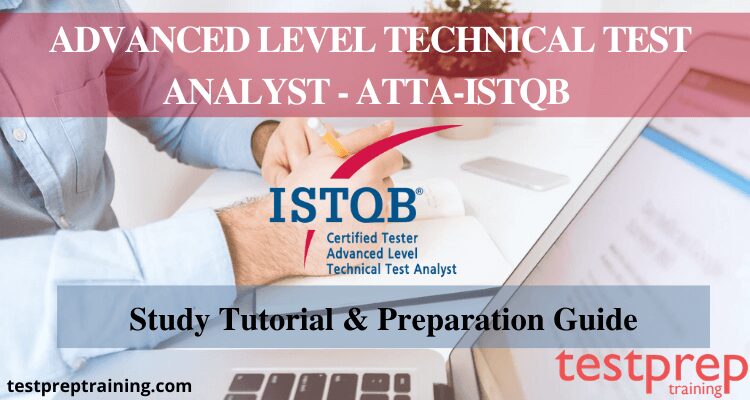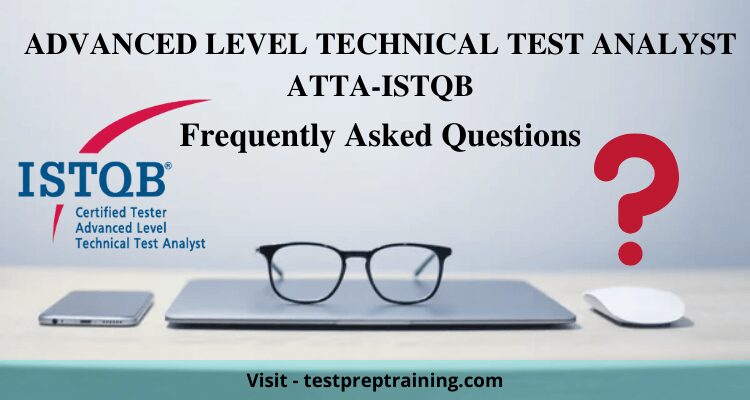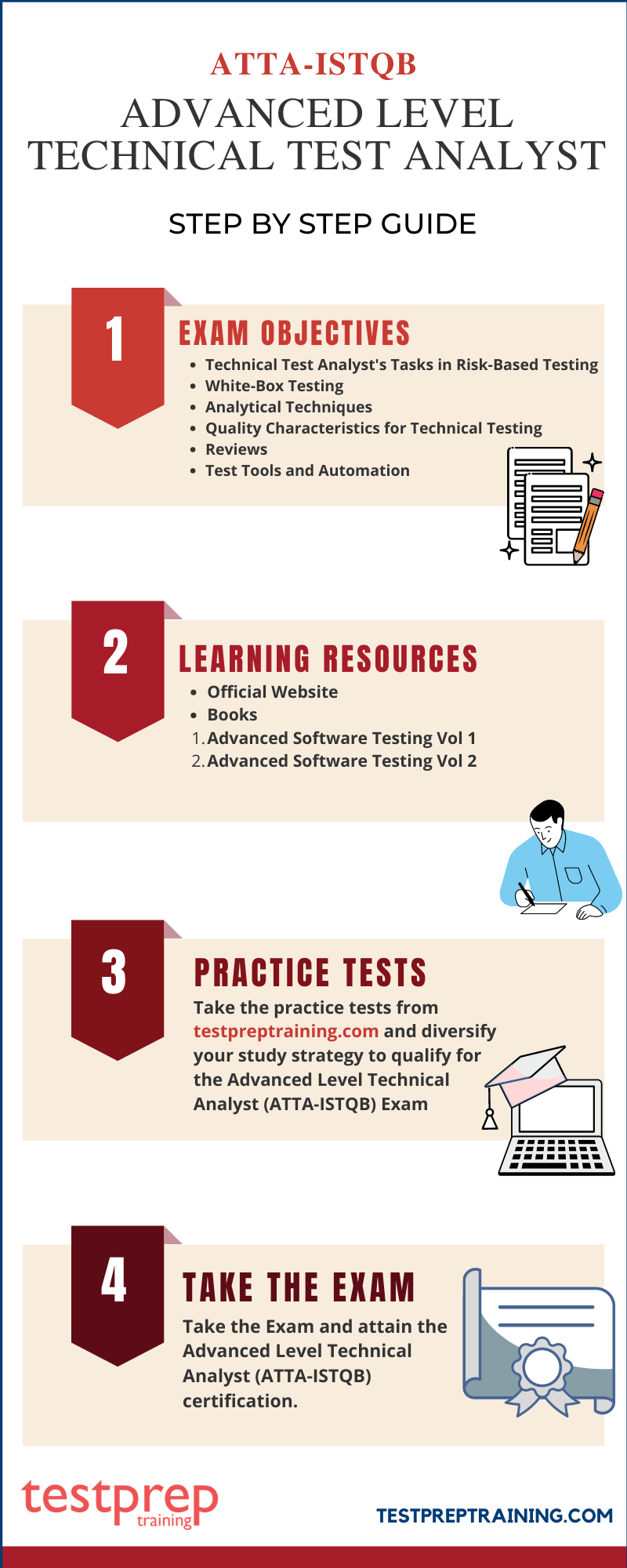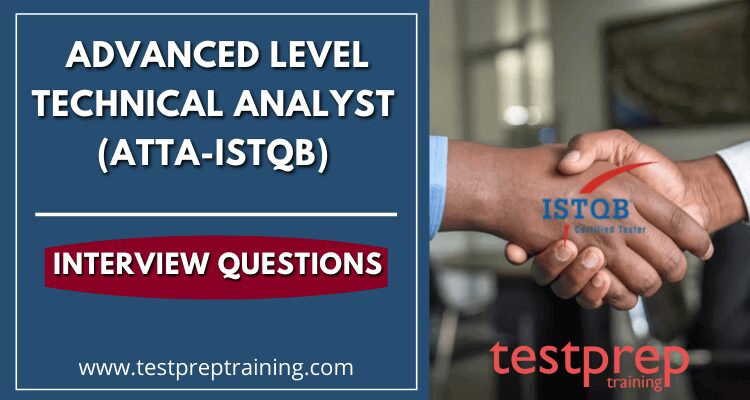ATTA-ISTQB | Advanced Level Technical Test Analyst

The Advanced Level Technical Analyst (ATTA-ISTQB) exam is planned for those who are able to identify and describe the usual risks associated with software systems performance, protection, reliability, portability, and maintenance. Candidates should also be able to include technical elements for the preparation, design, and implementation of performance, protection, reliability, functionality, and maintenance risk mitigation tests.
The Advanced Level Technical Analyst (ATTA-ISTQB) certificate is recognized on different continents in multiple countries. Both private and public companies are searching for their technical department to provide an advanced-level technical analyst. It has a lot of visibility and offers an applicant better positions and prospects for jobs.
Target Audience
Candidates and practitioners who want to be an Advanced Technical Analyst in an organization and who want to obtain this qualification. Graduates and professionals seeking a better position in a company and employment openings with earning potential will do wonders for them with this credential.
Prerequisites
The applicant must possess the relevant Foundation Level Certificate (Core or Specialist) obtained by passing the relevant Foundation Level exam in order to take an Advanced Level exam (Core or Specialist). It may be appropriate to prove the candidate’s possession of the Foundation Level Certificate. Before taking any advanced test, ISTQB also recommends practical experience. The applicant must hold the required Advanced Level Credential, as indicated for that particular Expert Level exam, to take the Expert Level exam. The Advanced Level Test Manager credential is required for the currently published Expert syllabus (‘Improving the Testing Process’ and ‘Test Manager’). The required Expert Level Certificates are shown in the “Expert Level Module Overview” guide. At least 7 years of practical experience is also recommended by ISTQB.
ATTA-ISTQB: Advanced Level Technical Analyst Interview Questions
Roles and Responsibilities of an Advanced Level Technical Analyst (ATTA)
Before enrolling for the examination, it is necessary to know about the tasks performed by the individual practitioner. Let’s see what the roles of an individual are as an ISTQB Advanced Level Technical Test Analyst.
- Recognize and distinguish the typical risks associated with software systems performance, protection, reliability, portability, and maintenance.
- Provide technical elements for planning, designing, and carrying out tests to mitigate the risks of performance, protection, reliability, portability, and maintenance
- Select and apply correct white-box test techniques to ensure that assessments, based on design coverage, provide an adequate level of trust
- Engage successfully in reviews with developers and software architects that apply knowledge of traditional code and design defects
- Improve the quality characteristics of code and design by using various techniques of analysis
- Set out the costs and advantages to be expected from the implementation of various forms of test automation.
- Undertake test automation, consider technological problems and principles.
Want to know, How much does ISTQB Certification Cost? Check below.
Exam Details
| Exam Name Advanced Level Technical Analyst | Exam Code ATTA |
| Exam Duration 120 mins | Exam Format Multiple Choice and Multi-Response Questions |
| Exam Type Technical | Number of Questions 45 Questions |
| Eligibility/Pre-Requisite As suggested* | Exam Fee Rs. 4580 |
| Exam Language English | Pass Score 65% and above |
For More Details See – ATTA FAQ – Advanced Level Technical Test Analyst

Course Outline
The ISTQB Advanced Level Technical Test Analyst certification exam covers the following chapters –
Chapter 1: The Technical Test Analyst’s Tasks in Risk-Based Testing
Introduction
Risk-based Testing Tasks
- (K2) Summarize the generic risk factors that the Technical Test Analyst typically needs to consider
- (K2) Summarize the activities of the Technical Test Analyst within a risk-based approach for testing activities
Chapter 2: White-Box Test Techniques
Statement Testing
- (K3) Write test cases for a given specification item by applying the Statement test technique to achieve a defined level of coverage
Decision Testing
- (K3) Write test cases for a given specification item by applying the Decision test technique to achieve a defined level of coverage
Modified Condition/Decision Coverage (MC/DC) Testing
- (K3) Write test cases by applying the Modified Condition/Decision Coverage (MC/DC) test design technique to achieve a defined level of coverage
Multiple Condition Testing
- (K3) Write test cases for a given specification item by applying the Multiple Condition test technique to achieve a defined level of coverage
Basis Path Testing
- (K3) Write test cases for a given specification item by applying McCabe’s Simplified Baseline Method
API Testing
- (K2) Understand the applicability of API testing and the kinds of defects it finds
Selecting a White-box Test Technique
- (K4) Select an appropriate white-box test technique according to a given project situation
Chapter 3: Analytical Techniques
Static Analysis
- (K3) Use control flow analysis to detect if code has any control flow anomalies
- (K2) Explain how data flow analysis is used to detect if code has any data flow anomalies
- (K3) Propose ways to improve the maintainability of code by applying static analysis
- (K2) Explain the use of call graphs for establishing integration testing strategies
Dynamic Analysis
- (K3) Apply dynamic analysis to achieve a specified goal
Chapter 4: Quality Characteristics for Technical Testing
General Planning Issues
- (K4) For a particular scenario, analyze the non-functional requirements and write the respective sections of the test plan
- (K3) Given a particular product risk, define the particular non-functional test type(s) which are most appropriate
- (K2) Understand and explain the stages in an application’s software development lifecycle where non-functional tests should typically be applied
- (K3) For a given scenario, define the types of defects you would expect to find by using the different non-functional testing types
Security Testing
- (K2) Explain the reasons for including security testing in a test approach
- (K2) Explain the principal aspects to be considered in planning and specifying security tests
Reliability Testing
- (K2) Explain the reasons for including reliability testing in a test approach
- (K2) Explain the principal aspects to be considered in planning and specifying reliability tests
Performance Efficiency Testing
- (K2) Explain the reasons for including performance efficiency testing in a test approach
- (K2) Explain the principal aspects to be considered in planning and specifying performance efficiency tests
Maintainability Testing
- (K2) Explain the reasons for including maintainability testing in a test approach
Portability Testing
- (K2) Explain the reasons for including portability testing in a test approach
Compatibility Testing
- (K2) Explain the reasons for including compatibility tests in a test approach
Chapter 5: Reviews
Technical Test Analyst Tasks in Reviews
- (K2) Explain why review preparation is important for the Technical Test Analyst
Using Checklists in Reviews
- (K4) Analyze an architectural design and identify problems according to a checklist provided in the syllabus
- (K4) Analyze a section of code or pseudo-code and identify problems according to a checklist provided in the syllabus
Chapter 6: Test Tools and Automation
Defining the Test Automation Project
- (K2) Summarize the activities that the Technical Test Analyst performs when setting up a test automation project
- (K2) Summarize the differences between data-driven and keyword-driven automation
- (K2) Summarize common technical issues that cause automation projects to fail to achieve the planned return on investment
- (K3) Construct keywords based on a given business process
Specific Test Tools
- (K2) Summarize the purpose of tools for fault seeding and fault injection
- (K2) Summarize the main characteristics and implementation issues for performance testing tools
- (K2) Explain the general purpose of tools used for web-based testing
- (K2) Explain how tools support the practice of model-based testing
- (K2) Outline the purpose of tools used to support component testing and the build process
- (K2) Outline the purpose of tools used to support mobile application testing
Preparation Guide for Advanced Level Technical Analyst (ATTA-ISTQB) exam
How do I prepare for ISTQB Advanced Level Technical Test Analyst? Having no idea where to begin leads to procrastination which is not suitable for this certification. Therefore if you don’t want to come across a procrastination scenario, the safest approach is to provide a guide for planning. There are all the essential resources listed in the Preparation Guide that will enable you to excel in the exam. Let’s get to the key points in the guide.

Learning Resource 1: Official Website
Going through the official website and research content is an important aid in the preparation. The resources available on the official website are readily accessible source modes and are thus approached by most people. Going through this stuff given will help in gathering the ISTQB Advanced Level Technical Analyst study material and also will increase your level of thinking in accordance with the requirements of the exam. Below are some of the resources which the ISTQB website has to offer to the candidates taking the ATTA-ISTQB exam.
- Contents
- Business Outcomes
- Learning Objectives
- Materials for Download for 2019 syllabus
- Materials for Download for 2012 syllabus
Learning Resource 2: Books
Referring to relevant books from expert authors is the second step in our planning guide. There are several reliable and appropriate books available for your preparation that you can go through before examinations. Books are an intelligible source of data and give you access to detailed concepts about the subjects.
Advanced Software Testing Vol 1: This book is written for a technical test analyst who wishes to learn advanced test analysis, design, and execution skills. This book shows you how to identify and carry out the tasks needed to bring a test plan into action with a hands-on, exercise-rich approach. You will be able to study for the exam with this book and it has ISTQB Advanced Technical Test Analyst exam questions for most of the learning goals covered by the ISTQB Advanced Level syllabus, at the required level of difficulty.
Advanced Software Testing Vol 2: The New ISTQB Advanced Test Manager 2012 Syllabus, and the current ISTQB Glossary, have been thoroughly revised to reflect this second version. This edition represents the unique insights of Rex Black into these improvements, as he was one of the ISTQB Advanced Level Working Group’s key participants.
Check Your Progress with Practice Tests
The typical aspect of exam training is ISTQB Advanced Level Technical Analyst practice tests. We have been aware of the practice test since schooling, which enables us to assess our results and measure ourselves in the course of preparation. Another important advantage is that practice exercises help you get familiar with the examination environment, and this will help you build confidence. It also improves the intensity and strengthens our weaker sections.


